This French Brioche bread recipe is buttery and soft with the perfect fluffy crumb. If you haven´t tried baking homemade brioche bread before, just wait until the delicious buttery smell fills your kitchen; you'll be hooked!
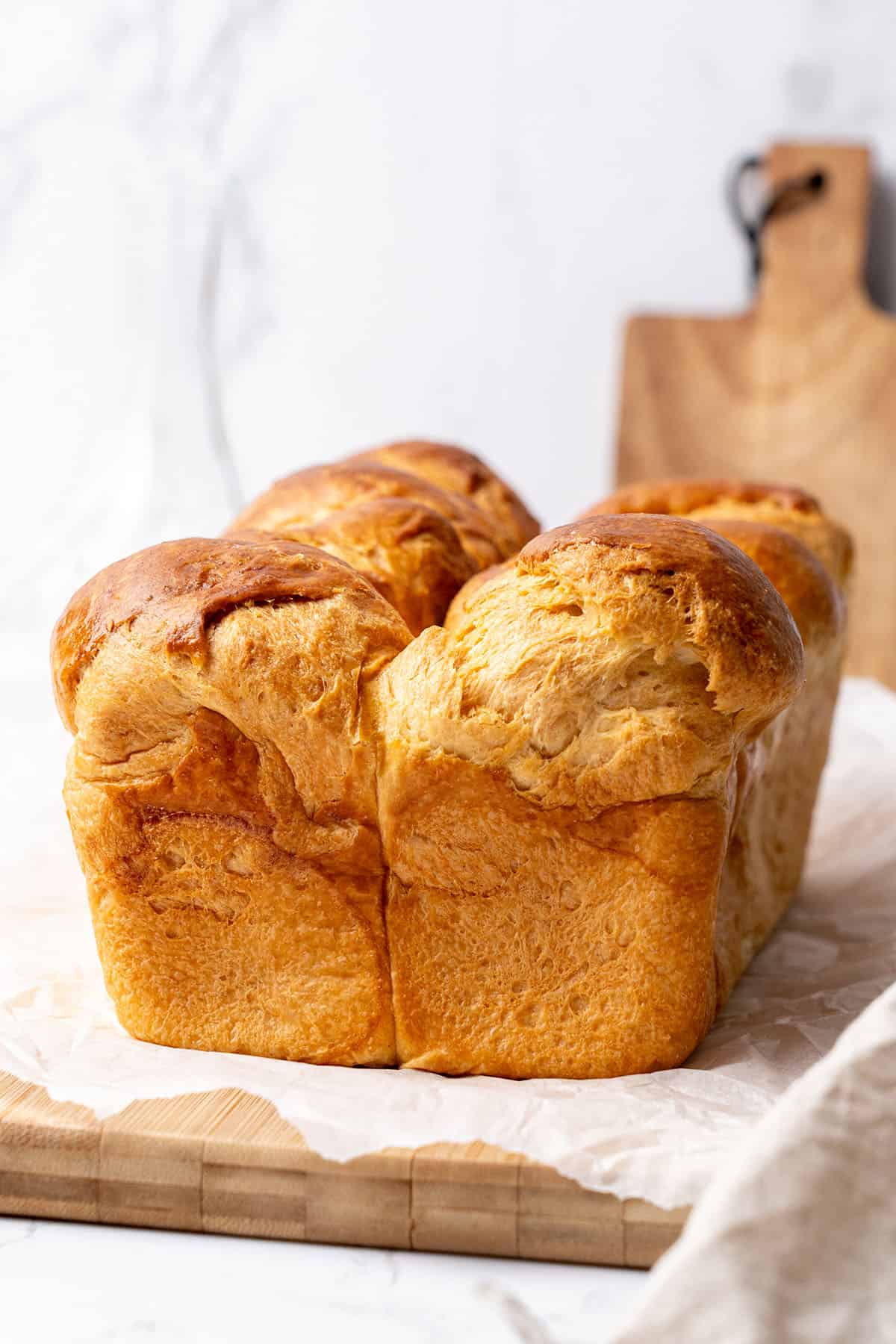
Jump to:
📖 What is French Brioche Bread?
French brioche bread is an enriched bread with French origins with a rich taste, buttery texture, and tender crumb. It is considered a Viennoiserie because it is made in the same basic way as bread, but with the addition of eggs, butter, liquid (milk, water, cream, and, sometimes, brandy), and occasionally sugar. The higher fat levels make it deliciously rich and soft and give it a signature dark glossy crust.
If you love French desserts, make sure to check out my ultimate list of the best French pastries with recipes!
🌟 Why this is the best recipe
- It's versatile - A good brioche is neither sweet nor savory, so it can be enjoyed in so many ways. I love it with jam or homemade Nutella or even with ham and eggs for breakfast.
- It's delicious - Once you've tasted freshly baked brioche, you won't be able to go back. The buttery taste and tender, puffy texture are simply irresistible.
- It's simple - Whilst it might be a yeasted dough with more steps than usual, the ingredients for brioche are still very basic. What's more, I'll talk you through exactly how to make this easy French brioche bread recipe. Even beginner bakers can do it!
- It's special - Eating and serving your own home-baked brioche is special; you will love it! It's a heartwarming and exceptionally comforting experience.
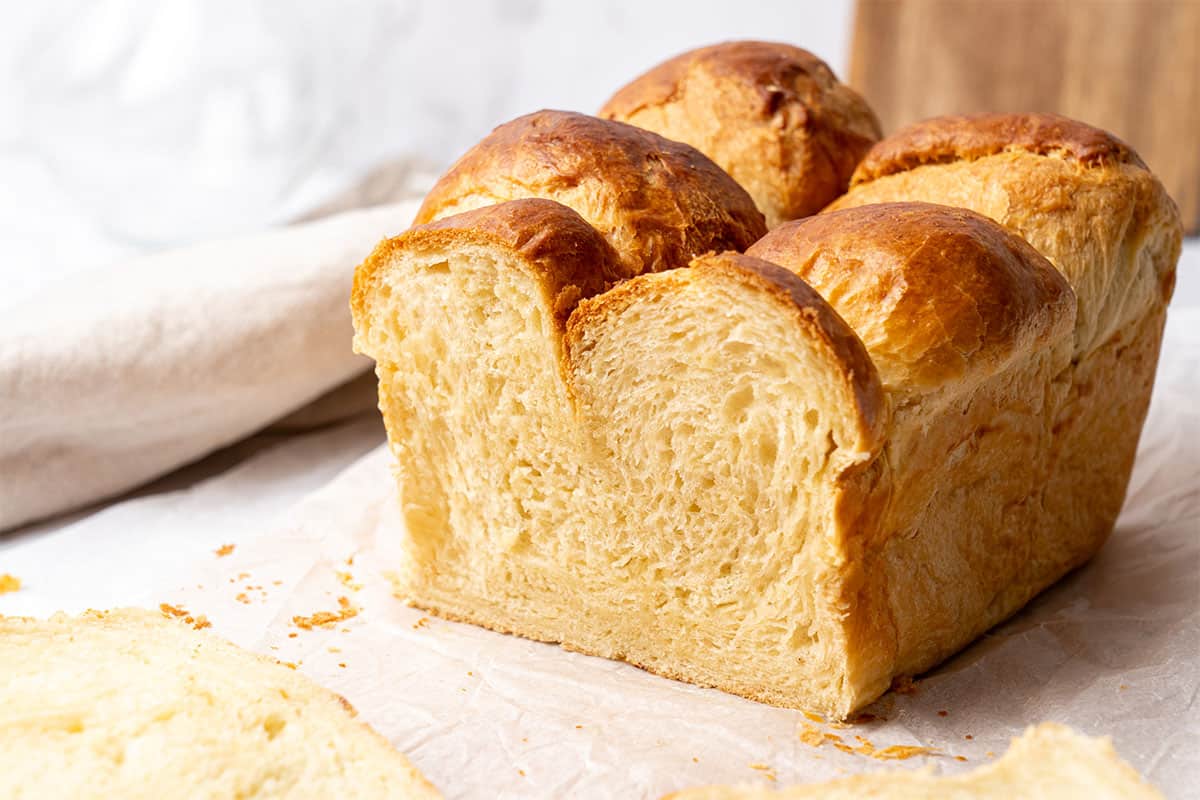
📝 Ingredient notes
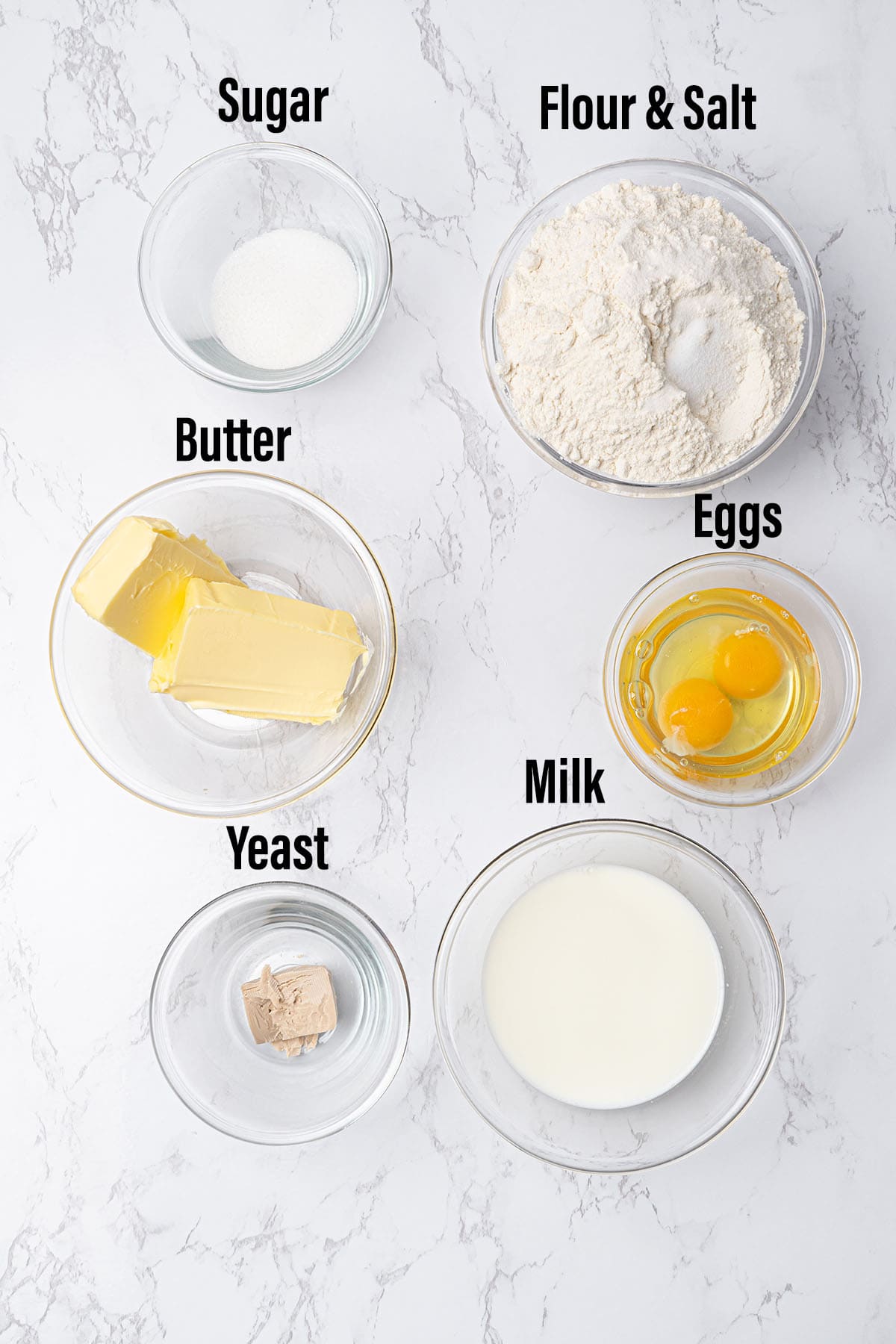
- Butter - Always use unsalted butter in baking to remain in control of the quality and quantity of salt in a recipe. I use European-style butter with 82% fat-content butter in all my recipes. The butter needs to be soft enough to knead into the dough but not melted or runny. Avoid last-minute microwaving! Did you know you can make your own homemade butter?
- Sugar - French Brioche is not a particularly sweet bread, but a small amount of sugar is needed to make this recipe. If you want to learn about the different types of sugar and how to use them in baking, read my sugar guide.
- Yeast - I use fresh yeast in this recipe. However, you can use dry yeast too, but make sure you calculate the right quantity. Please check your local brand and calculate accordingly or read my yeast guide for conversions.
- Milk - Use whole milk at room temperature, so take it out of the fridge before use.
- Egg - There is both a whole egg and extra egg yolk in this recipe to make it extra moist and rich. Always use room-temperature eggs. We also need extra for an egg wash. Eggs are baking superheroes, and to learn more about eggs and what they do in baking, read my guide.
- Flour - As brioche is a type of bread, you will need to use a high protein content bread flour, which contains more gluten and helps to achieve that lovely, airy, and chewy texture everyone loves. If you cannot get hold of bread flour, you can use all-purpose flour. Read my flour guide for more information.
- Salt - This is an essential ingredient even in dessert recipes, as it balances and enhances all the flavors. Do not add salt directly to yeast, as it kills it.
🛒 You’ll find detailed measurements for all Ingredients in the printable version of the Recipe Card at the bottom of this post
👩🍳 How to make this recipe
1. How to assemble the brioche dough
- Gently heat the milk and half the sugar in a saucepan just until it is lukewarm, and sprinkle the yeast on top. Leave it to activate for 10 minutes off the heat; it should go foamy.
- Place the mixture and the egg into the bowl of your stand mixer fitted with the dough hook. Mix for a minute until fully combined.
- Add the flour and the rest of the sugar plus a pinch of salt, and continue mixing/kneading with the help of the dough hook.
- After a few minutes, start to slowly add the room-temperature butter, one tablespoon at a time. Keep your stand mixer running, and wait for each piece of butter to be incorporated before adding more.
- Once you have added all the butter, knead for approximately 10 minutes further on medium-high speed. The dough will become super shiny and elastic, and you will achieve the gluten window as per the picture below.
- Prove the dough in a bowl covered with plastic food wrap at warm room temperature (23-25C / 73-77F) until doubled in size.
- Punch the dough out, form a ball again, and place it into the fridge to prove again for 8-24 hours.
💡 Top Tip: If the yeast does not start foaming after 10 minutes, the dough will not rise, so start again. Make sure the milk is only lukewarm and not hot, as this can kill the yeast.
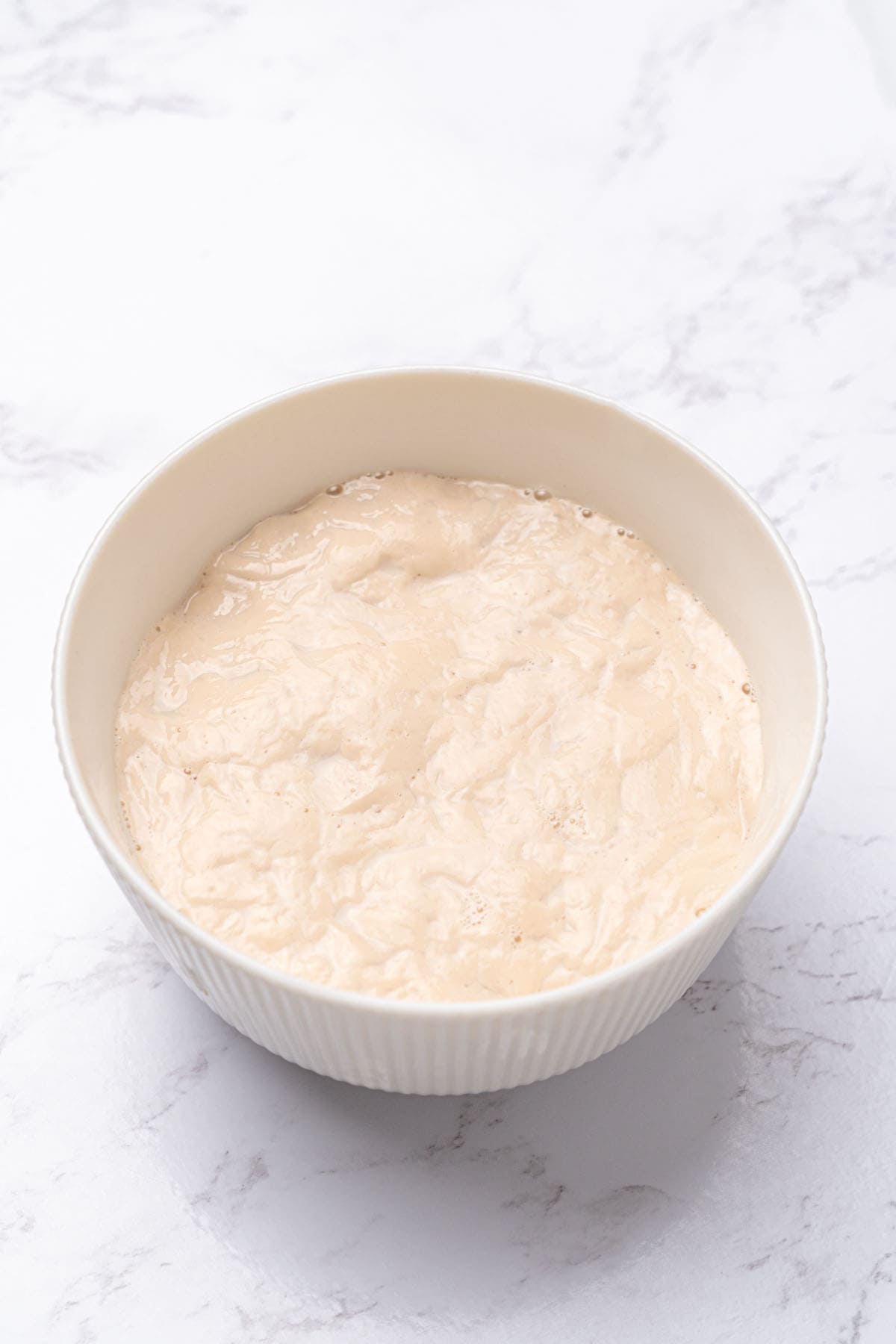
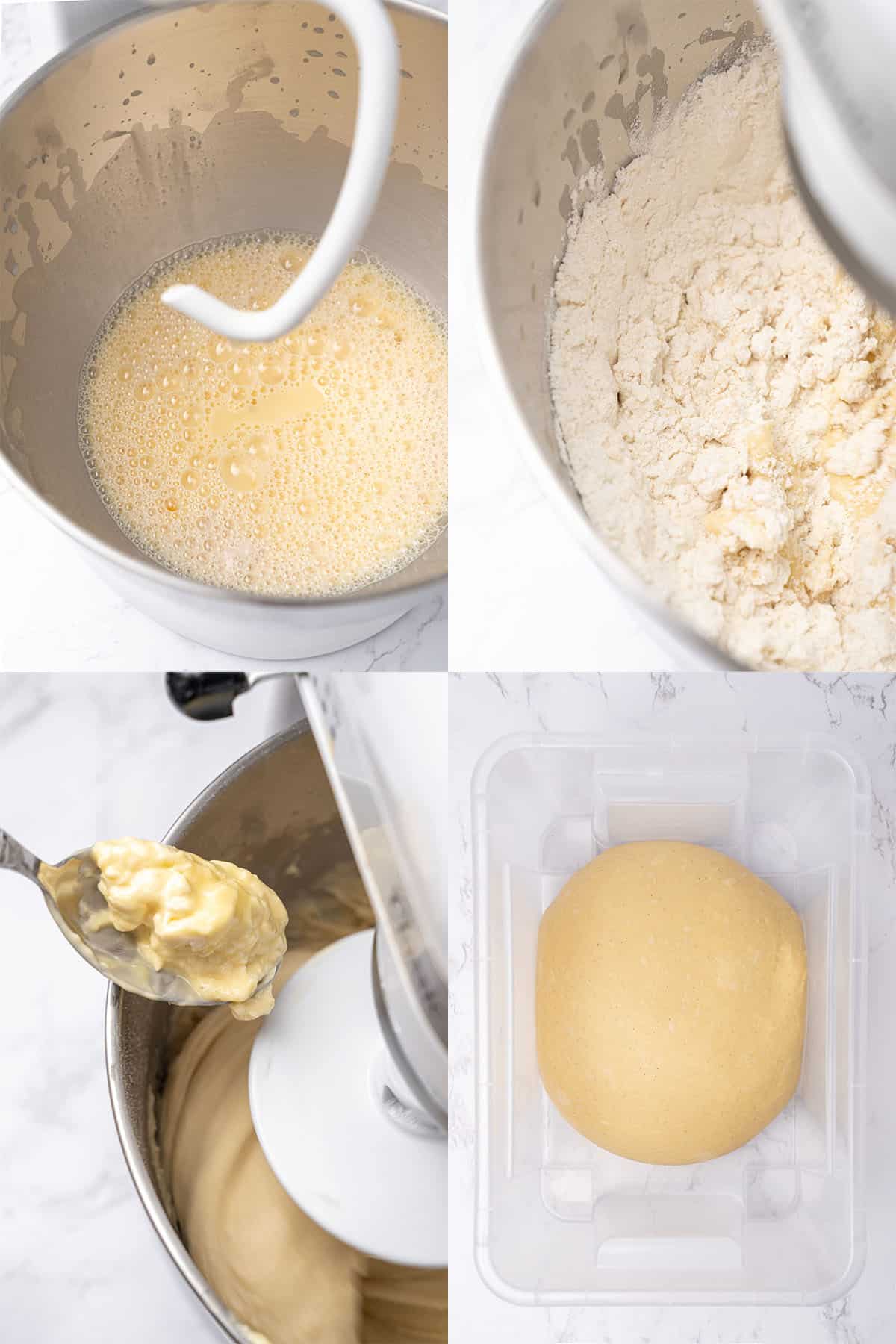
How to bake French brioche bread
- After the second rise in the fridge, punch the air out of the dough again.
- Cut the French brioche dough into 8 equal pieces (weigh them so they are even)
- If baking in a loaf pan, arrange it according to the shape of your pan eg. 2-2-2-2.
- Brush an egg wash over the surface of the brioche dough balls. Cover the dough and place it in a warm (but not hot) place for their final proof. This will take 1-2 hours until they have roughly doubled in size.
- Towards the end of the 3rd rise, preheat your oven to 180C / 356F (no fan).
- Once the dough doubles in size, place it into the oven and bake the French brioche bread for 45 minutes. Do not open the oven for the first half of the baking time. If it is browning too much, cover it with an aluminum foil after 20 minutes.
- Melt a small amount of butter and brush it over the surface of the baked brioche bread to get that signature glossy, buttery surface.
- Let the French brioche bread rest in the baking tin for 3-5 minutes before turning it out onto a wire cooling rack.
💡 Top Tip: It helps to roll out the easy brioche dough balls using a Silicone baking mat. This stops them from sticking, so you do not have to use dusting flour.
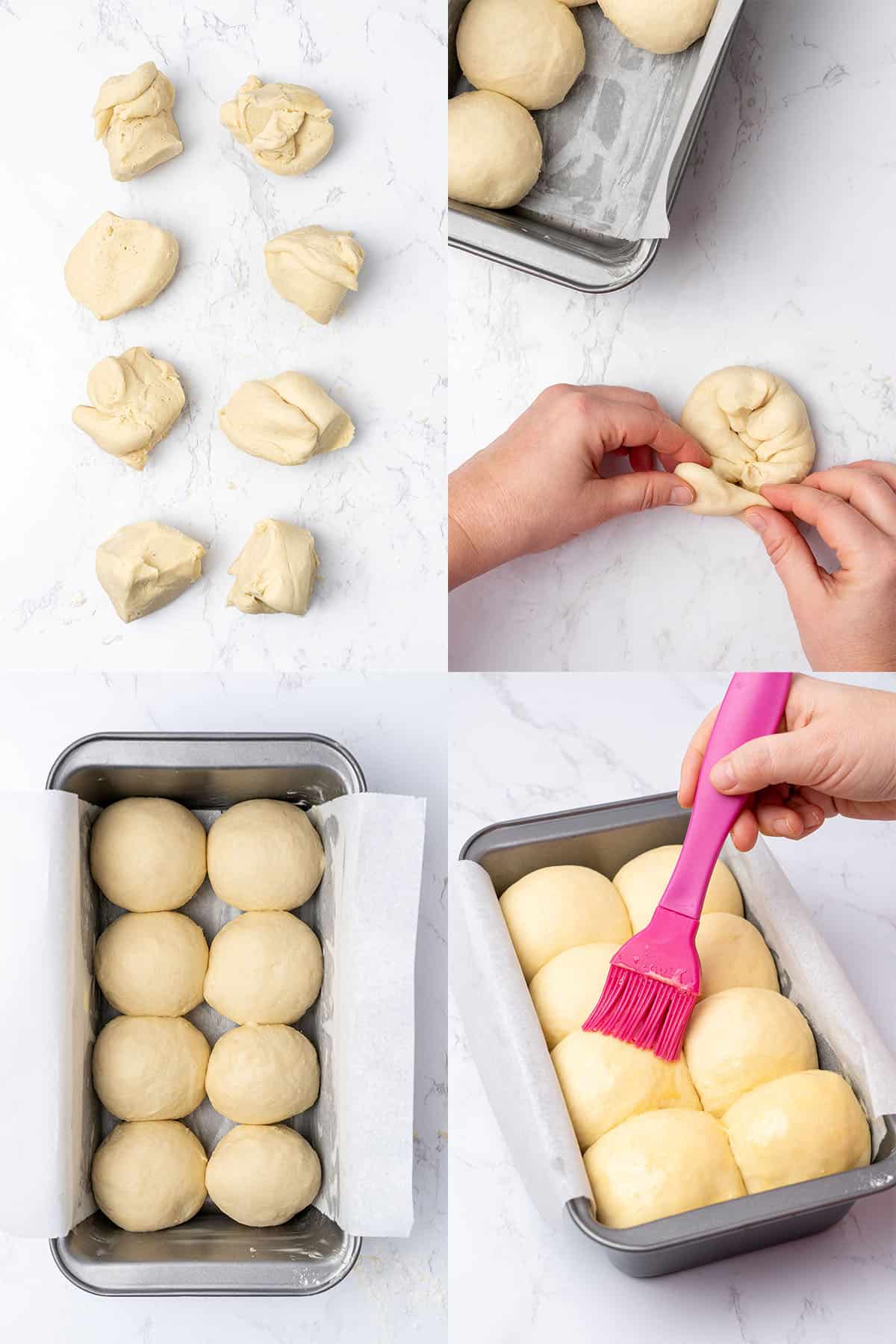
👩🍳 Storage & freezing
Store French brioche bread at room temperature and use within 2-3 days. Keep it in an airtight container to prevent it from drying out, and either enjoy it fresh or toasted.
You can also put brioche in the freezer, and it freezes very well. To freeze brioche bread, double-wrap it in plastic wrap and aluminum foil. Defrost and use within one month. I sometimes slice a brioche loaf in half and freeze half of it to keep it fresher for longer.
📚 Flavor variations and substitutions
French brioche bread is so versatile, and once you have mastered the recipe, you can adapt it in so many ways. Add chocolate chips or grated orange zest to the dough to give even more flavor and make this into a tasty dessert. Dust powdered sugar over the top before serving warm and fresh from the oven. You could also add chopped nuts to the dough, similar to my delicious walnut babka recipe.
Sprinkle sesame seeds on top after the egg wash for a more savory version with added crunch. Add black onion seeds for some color variation and even more flavor! Brioche is delicious as bread for sandwiches, fancy brunch, or a side for dinner parties.
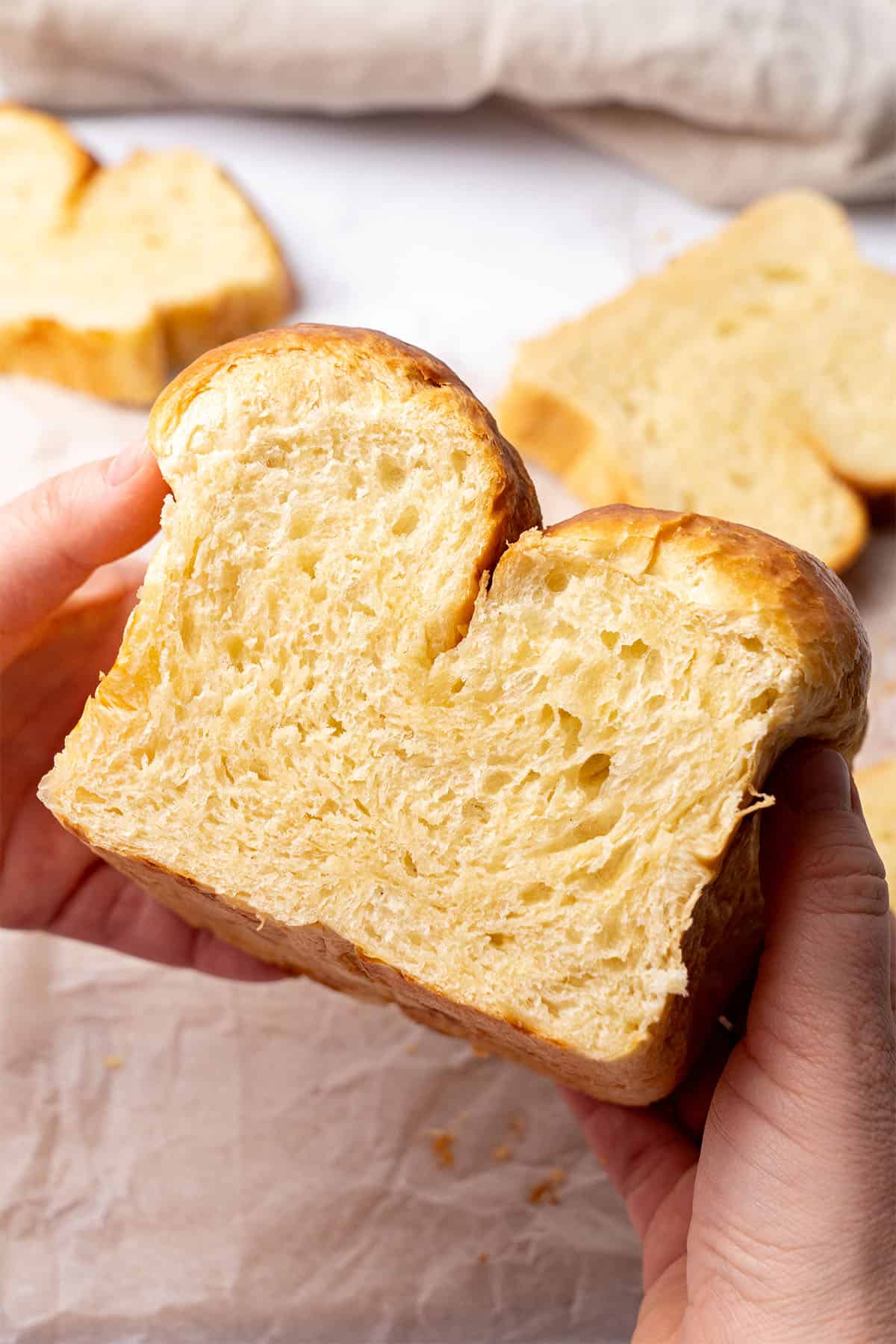
To make this brioche dairy-free, you can substitute butter with vegan butter. Read my baking substitutes section and baking guides to learn more about making other swaps, especially my article on baking with yeast if you are substituting fresh yeast for instant or dry yeast.
If you love baking brioche from scratch, try some of these other European desserts, too.
🎓 Expert tips to make French brioche bread
- Read the recipe carefully, including my tips and recommendations. The most important thing to consider is giving enough fermentation time to the dough. Factor this in when deciding when you would like to eat it!
- Weigh all of your ingredients and make sure they are at the correct temperatures. The butter needs to be soft, so take it out of the fridge with enough time before you begin this French brioche recipe. Always use room temperature eggs in baking.
- Use strong, high protein flour for best results, but all purpose flour will be ok if it is all you can find.
- If you are using instant yeast, or active dry yeast instead of fresh yeast, check the quantities to make sure you use the right amount.
- If the simple brioche dough tears during the window test, knead it for another minute and then check again.
- Make sure you do not skip the overnight rise in the fridge. This is essential for a beautiful crumb and texture; it develops flavor and makes it easier to shape and work with.
- To check if your dough is correctly proven, press a finger into it. If the indent bounces straight back, it needs more time. If the indent stays or comes back halfway, it is ready. If the dough deflates, it is over-proofed.
- Don't place the dough balls too close to one another in the tin, as they will expand as they rise.
- Avoid speeding up the final rise with your oven. This almost always leads to over-proofed brioche. The ideal proving temperature is 23-25C / 73-77F.
- This recipe includes 3 proofing for the best texture and flavor. If you are in a rush, you can skip the overnight proofing and just have the first (the dough as a whole) and third proofing (right before baking) however I do not recommend it.
🥣 Equipment notes
Always weigh ingredients by the gram using a Digital scale for best results. Baking is a science, and measuring by volume (e.g., the US cup system) is not precise enough for consistent results.
All ovens vary, and I recommend investing in an inexpensive Digital oven thermometer to check you are baking at the right temperature. Most issues that arise with baking come from oven temperature! Do not use the fan setting. And check my tip on preheating the oven hotter and turning it down once the brioche is inside. This allows for a natural drop in temperature when you open the oven door, so the baking environment ends up being the correct temperature.
If you don't feel like kneading by hand, a Stand mixer fitted with the dough hook attachment is a super handy tool for busy bakers. It makes this French brioche bread recipe easy!
Using a Silicone baking mat is a great tool to shape the dough with no sticking, so no need for extra dusting flour. Alternatively, work your brioche French bread on a lightly floured work surface.
The recipe works for a large (27x15cm / 11x6 inches) loaf pan.
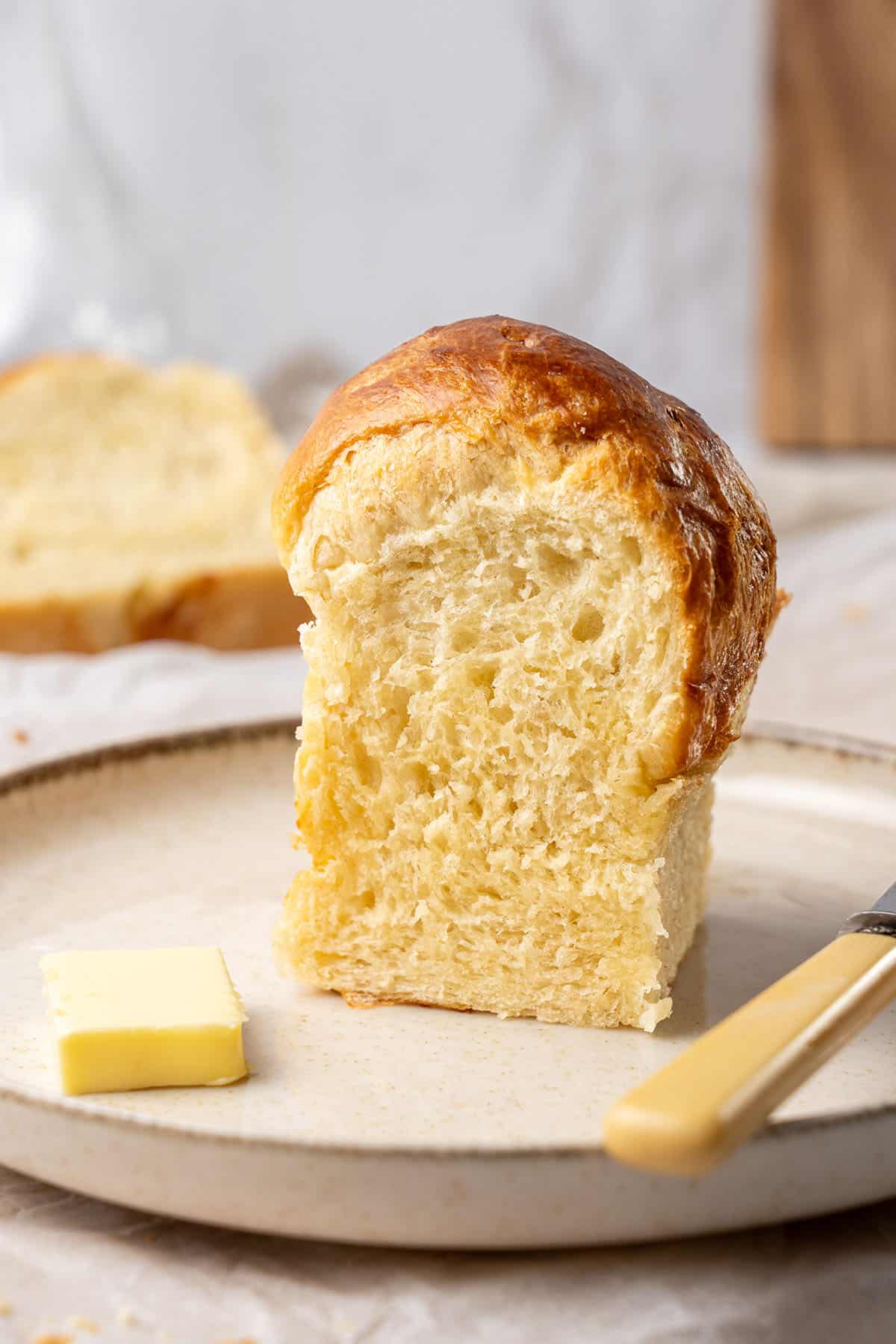
❓Recipe FAQs
Toast brioche bread and serve it with strawberry compote or walnut butter, or for a savory option, top it with sliced ham and poached eggs.
Brioche is an enriched bread, so the basic ingredients and method are similar, but there is added fat from butter and eggs, which gives it a very tender bite and rich taste.
No, not especially. Brioche does contain sugar but is not inherently sweet. It can be used in both savory dishes as well as desserts like French toast.
Yes! French brioche bread French toast is the best kind.
👩🍳 More sweet bread recipes
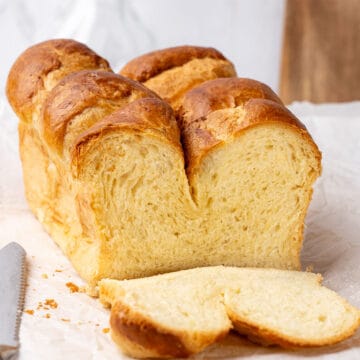
French Brioche bread
Equipment
- Digital scale
Ingredients
Brioche bread
- 165 grams (⅔ cups) Whole milk lukewarm.
- 67 grams (⅓ cups) Granulated sugar
- 17 grams Fresh yeast 7g (2¼ teaspoons) active dry yeast
- 2 Egg at room temperature.
- 375 grams (3 cups) Bread flour use high protein content flour.
- ½ teaspoon Salt
- 170 g (¾ cups) Unsalted butter at room temperature.
- egg with splash of water or milk for the egg wash.
- small amount of melted butter for the glaze.
US customary cup measurement is an indicative figure only. Measure the ingredients with a digital scale by weight (gram). Baking is art but also science which requires precision and accuracy.
Instructions
- Heat half of the sugar with the milk just until lukewarm, then remove from the heat and sprinkle the yeast on top. Leave it for 10 minutes and the yeast should foam.
- Place the yeast mixture into your Stand mixer with the kneading hook on, then mix it with the eggs.
- Mix in the dry ingredients: bread flour, the rest of the sugar, and a pinch of salt, and keep the mixer running to knead the dough until it comes together. This will take about 3 minutes.
- Slowly add in the softened butter piece by piece while the mixer is on, and once all the butter is in, knead for around another 10 minutes on medium-high speed. The dough will become elastic and shiny. Once you have achieved the 'gluten window' (see photos above), stop kneading.
- Move the dough into a bowl, cover it with plastic wrap, and let it rise at room temperature for 1-2 hours, or until the dough doubles in size. Then punch it out, re-shape it into a bowl, and put it in the fridge to rise again for a minimum of 8 hours or up to 24 hours.
- The next day, divide the dough into 8 equal pieces and roll them into balls. Use a Silicone baking mat to help shape the dough without needing dusting flour.
- Grease a large (27x15cm / 11x6 inches) loaf pan tin with arrange the dough balls as 2-2-2-2.
- Mix an egg with a splash of water, and brush an egg wash over the surface of the dough. Allow the brioche to proof for a further 1-2 hours until the dough doubles in size and fills the tin.
- Preheat your oven to 180C / 356F towards the end of the proofing time.
- Place the French brioche bread into the oven and bake for about 45 minutes until golden brown.
- Remove from the oven and brush a small amount of melted butter over the top of the brioche. Leave it to cool for a few minutes before turning it out onto a wire cooling rack.
Notes
- Always weigh ingredients by the gram using a digital scale to use the correct amounts.
- If your yeast mixture does not foam after 10 minutes, start again. Make sure the milk is only lukewarm and not hot, as this can kill yeast.
- For best results, use flour with high protein content, often labeled as bread flour. But all-purpose flour can be used instead if necessary.
- The butter needs to be soft but not melted or runny. Learn here how to soften butter quickly.
- The dough has proved sufficiently when you press it gently with your finger, and the indent stays there, or only half bounces back. If it bounces straight back, it needs more time to prove.
- Do not skip the long cold ferment in the fridge, between 8-24 hours. This is essential for flavor and texture, plus, it makes the dough easier to handle.
- Use an oven thermometer to always bake at the right temperature.
- If the brioche is browning too fast in the oven, cover it with aluminum foil for the final 10 minutes of baking time.


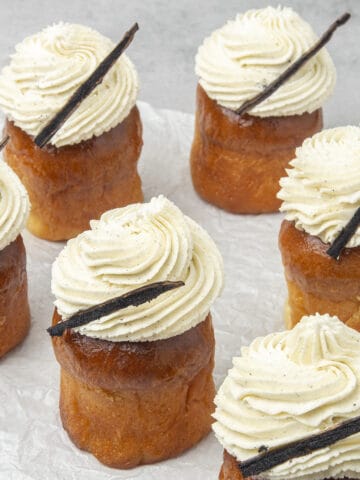

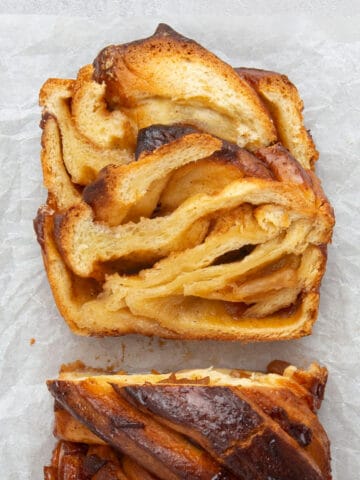

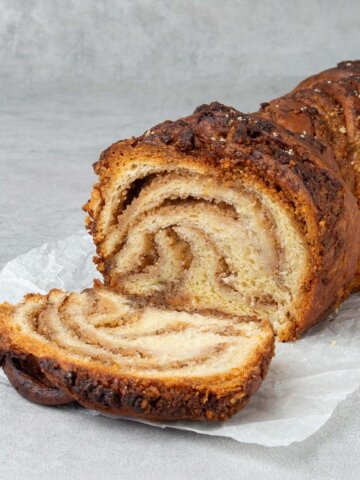

Leave a Reply